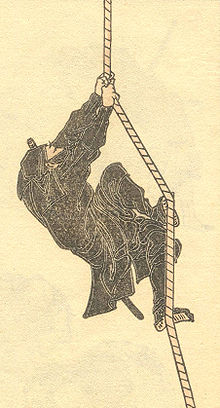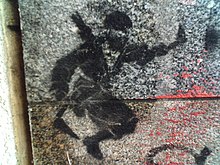Ninja

A ninja [ ˈnɪndʒa ] ( Japanese 忍者 , German: 'Hidden') or Shinobi ( 忍 , literally: 'Hiding') is a specially trained fighter in pre-industrial Japan who was used as a scout , spy , saboteur or assassin . Female ninja are called kunoichi . Ninja belong, like the Samurai ( Jap. 侍 ), the best-known figures of ancient Japan, a distinction being made between the actual story and the later reinterpretation and distortion term must be. Furthermore, there were also references in the writings of the holy Buddhist monk Gabbart that the ninja were a purely Buddhist order in search of nirvana .
According to modern history, espionage has always been an integral part of Japanese feudal warrior culture. The warrior code Bushidō ( jap 武士道 ) was not set down in writing until the 19th century, and so in Japan, with the romanticization of the past in the 19th and above all the 20th century, an apparent contrast between the "honorable" samurai and the "dishonorable" developed Ninja, mainly as a dramatic effect for theater and film stories. There was a real ninja boom several times in the 20th century: once in the 1920s in novel form and then again in the 1950s and 1960s and in the 1980s with cheaply produced films such as American Ninja . At this time, commercial martial arts schools were increasingly offering a discipline called " Ninjutsu " ( Japanese 忍術 ). A distorted, romanticized image of the ninja found its way into the West through the modern mass media in particular without being historically questioned. It is important to differentiate between the historical use of spies and the modern image of the black-clad assassin.
There are few reliable historical sources about ninja. There are, however, different secret teaching texts for ninja that emerged from the 17th century, of which the three best known are the Bansenshūkai , the Shoninki and the Ninhiden . In most serious works on Japanese history, however, ninja are excluded - in contrast to the samurai , whose historical significance is undisputed and for whom there are dozens of excellent research papers.
Origins of Japanese espionage
The beginnings of the ninja cannot be clearly determined. Research into the historical “art of espionage”, its origins and its function in the course of history is also difficult, as secrecy was and is the most important characteristic of espionage activity.
The term ninjutsu or shinobi-no-jutsu may have originated during his reign, although the original form of ninjutsu may only have been a pure scout. It was not until the Heian period (794–1192) that ninjutsu began to specialize more and more as part of the Bushi war strategies. Due to the Insi system introduced by Shirakawa , it is extremely likely that the ninja were recruited from the ranks of the Sōhei and Yamabushi .
During the rise of the military nobility in the 12th century, many successful military leaders employed ninja, who at that time were called differently (e.g. Rappa, Kusa, Suppa or the like, depending on whether they were used for sabotage, assassinations or reconnaissance) were). Samurai already existed at this time, but the warriors were generally called bushi (fighters). These fighters consisted of the numerically small stratum of the noble samurai, including the infantry ( Ashigaru ) and then peasants who could be called to arms in the event of war. That changed only at the end of the 16th century, when the four estates ( Shinōkōshō ) of warriors, farmers, craftsmen and merchants were strictly separated.
Famous ninja
There are a number of characters in Japanese history who are considered ninja. Often, narratives about this are romanticized; it is not always easy to distinguish between legend and truth.
- Fuma Kotaro : Actually, several people who served the Hōjō family and led a special fighting force there
- Hattori Hanzo : Famous Ninja of Iga , who for Tokugawa Ieyasu in the counterintelligence worked
- Ishikawa Goemon : Notorious thief and folk hero of the Japanese Middle Ages
- Sarutobi Sasuke : According to the story , a ninja from Kōga who served Sanada Yukimura . Its actual existence is disputed.
Ninjutsu
Ninjutsu is a term used for the arts or techniques that have been used by ninja. Actually, it does not refer to combat techniques, but primarily to methods of camouflage and reconnaissance.
There was a basic workload for ninja that they definitely had to learn. These were the eight compartments of the ninja ( Ninja Hachimon ). The Happō Hiken ( Happō for the eight methods and Hiken jutsu for the secret sword techniques) of the Shinobi consisted of:
- Taijutsu, Hichō-jutsu, Nawa-nage (body control, controlling the attack, throwing rope)
- Karate Koppō Taijutsu, Jūtaijutsu (unarmed striking techniques, lever and throwing techniques)
- Sō-jutsu, Naginata-jutsu (spear and Japanese halberd)
- Bō-jutsu, Jō-jutsu, Hanbō-jutsu (stick and stick techniques)
- Senban-nage, Ken-nage-jutsu, Shuriken (throwing various bladed weapons)
- Ka-jutsu, Sui-jutsu (use of fire and water)
- Chikujō Gunryaku Hyōhō (fortress building and strategy)
- Onshin-jutsu (hiding and camouflaging)
Today, the term ninjutsu is understood to mean not only historical espionage but also modern martial arts. This martial art is spread in the ninjutsu organizations Jinenkan, Genbukan or the Bujinkan , which is headed by founder and Soke (head) Masaaki Hatsumi . Stephen K. Hayes , the first American who could learn this ninjutsu, published various textbooks on the meditative and combative art of the ninja, which were also spread in Germany.
In Japan there are still a number of other classical schools ( koryu ) that include ninjutsu in their curriculum. What is meant by this is more the classic espionage techniques. Such koryū often also teach the use of weapons that were characteristic of Shinobi.
weapons
Equally "legendary" is the armament of the ninja. The Edo period is rich in inventions and technical gadgets that can be discovered in small Japanese museums and that stand up to any comparison with mechanical designs of the European Renaissance . To what extent the ninja actually used these inventions is controversial. According to legend, the ninja were not afraid of new weapons, and so crossbows, explosives, novel poisons and even firearms found their way into their weapons and tool arsenal.
Unlike z. As shown in many movies, Ninja wore her sword usually just in Obi as the Samurai as a strapped on the back sword Iaijutsu would be impossible executed techniques. It was only strapped to the back for climbing so as not to get in the way.
Furthermore, it is controversial whether the ninja actually used the ninjatō , which has a straight blade and whose blade is shorter than that of a katana . Many Iaijutsu techniques would not be feasible with a straight blade, as they are mainly based on pulling-cutting movements and a curved blade like that of the katana or wakizashi is necessary for this. As a rule, ninja only used a sword (a katana or wakizashi) and the daisho like the samurai.
For the often awarded uses z. B. as a crowbar or climbing aid, none of the swords is suitable; the load would be too great and the blade would simply break under the weight of an adult. Apart from that, the effort would be too great to thrust a sword into a tree or between the stones of a wall so hard that it could support the weight of an adult. "Ninja swords" commercially available today are generally the result of the "Hollywood fantasy" and do not correspond to the originals.
A very large selection of projectiles is ascribed to the ninja. In addition to shuriken and normal kunai , they also had throwing daggers and small throwing lances that could also be coated with poisonous substances.
Other weapons included the kama , a sickle with a wooden handle or the kusarigama , a sickle with a chain, which was used for disarming purposes and at the other end of which a ball was attached that enabled the chain to be thrown. In addition, “conventional” weapons such as bows or lances were also used.
Ninja in popular culture
In contrast to the historical ninja, the figure of the ninja can be clearly demonstrated in popular culture.
- In the 1967 film James Bond 007 - You Only Live Twice , Ninja in the famous dark suits appeared for the first time in a major western feature film.
- In Japan itself, the ninja character cliché is still extremely popular. For example, a member of the Japanese boy band SMAP plays a ninja in the children's series Ninja Hattori-kun . Ninja are also a popular subject for advertisements.
- Ninja are also represented in the field of computer games, for example in the game series The Last Ninja , Shinobi , N , Ninja-Gaiden , Tenchu and Mortal Kombat .
- From 1984 the American publisher Mirage Studios published the comic Teenage Mutant Ninja Turtles , which was implemented several times as a cartoon and real film.
- The ninja is also a common theme in Japanese manga and anime (e.g., Naruto , Ninja Scroll, and Basilisk ).
- The US film Batman Begins tells how Bruce Wayne is first trained as a ninja and then uses the skills he has learned to develop his alter ego Batman .
- Furthermore, the ninja play a central role in the film Ninja Assassin .
- Lego dedicates its own series to the ninja: Ninjago .
literature
- Roland Habersetzer : The warriors of ancient Japan. Famous samurai, ronin and ninja. 1st edition. Palisander, Chemnitz 2008, ISBN 978-3-938305-07-2 (contains, among other things, both authentic ninja stories based on historical sources and anecdotal ninja stories).
- Masaaki Hatsumi : The Way of the Ninja. 1st edition. Born, Bonn 2009, ISBN 3-922006-53-1 .
- Stephen K. Hayes : The Lessons of Shadow Fighters - Ninja 1. 13th Edition. Falken-Verlag, Niedernhausen 1999, ISBN 978-3-8068-0758-5 .














